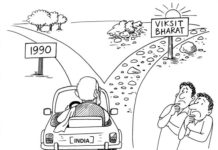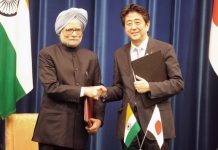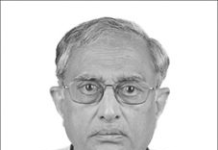MARKET PERSPECTIVE
By J Mulraj
JULY 26- Aug 1, 2025
Challenges that India faces
Image created by Bing
India faces a lot of challenges, and these will only grow. Some of these are:
Challenges of Regulation: Recently, a large New York based trading firm, Jane Street, was hauled up by market regulator SEBI, for market manipulation, it sought a fine of $ 566 m. which Jane Street promptly paid, and was allowed to continue operating in India. Purportedly Jane Street had made $ 4.3 b. in trading profits, so didn’t mind paying 13% of profits to SEBI.
Jane Street played in two markets, which is permitted. It bought large chunks of bank shares, primarily HDFC Bank (the most liquid) and ICICI Bank. Both of them account for 53% of the Nifty Bank Index, a compilation of 12 bank stocks. The Bank index is also in the derivative market. As a result of large purchases the stock prices of both banks went up and, since they have a large weightage in the Nifty Banking Index, so did the index.
Just Street short sold the Nifty Bank Index, just before the expiry date, leveraging it’s position. It then sold it’s physical holding of HDFC/ICICI Bank shares, bringing down their stock prices, and with it, the Nifty Bank Index. It made a huge profit in the derivative market because of this manipulation.
Jane Street plans to contest SEBI’s claim saying it has done nothing illegal. But Deepak Shenoy, CEO of an AMC, says their action amount to ‘marking the close’ which is considered illegal in USA too.
The challenges to Indian regulators are two. 1. Why was the Nifty Bank Index (and perhaps others) so poorly constructed that 2 out of 12 stocks have a 53% weightage, making it amenable to such manipulation. And, if the index is so constructed, why does NSE/SEBI permit it to be traded in the derivative market? 2. Are regulators up to date with international trading methods/rules, and can they exercise enough control over things like high frequency trading to be able to protect retail investors?
Challenges of the labour market: India’s population is 1.4 billion. Of this, as per the Economic Survey, 46% are dependent on agricultural income but have only a 16% share of GDP. The terms of trade are clearly iniquitous. Manufacturing, Services and Government absorb the rest.
Last week, India’s largest IT services firm, TCS, laid off 12,500 employees. Emerging technologies like AI threaten to displace human labor. Companies like Tesla have developed humanoid robots. Because they work 24 X 7 X 365 with no leave or strikes, the labor cost/ hour of humanoid robots is expected to be $10/ hour when introduced, falling to $1/ hour by 2035, lower than the minimum wage. Other cost factors will also be lowered significantly, using technology. Cost of mobility will be 4 to 10 times cheaper. Of protein, it will drop to 10-20% of current costs. Of energy, it will drop from an average cost of 16 cents/ kWh to just 3.
On top of this is the challenge of dealing with an illogical and, unsupported by the US Congress, illegal, tariff war. Trump has unilaterally imposed a 25% tariff on India and threatens to impose unquantified penalties for supporting Russia through the purchase of it’s energy and it’s military equipment. Who on earth made him an arbiter? His megalomania has led to the announcement of sanctions on a Brazilian Supreme Court judge who wanted to investigate the former President, Bolsonaro, (a friend of Trump) for trying to overthrow an election.
But for India, given it’s already over dependence on agriculture for job creation, as well as it’s apparent lag in development of AI (developed countries are set to reach ASI, or Artificial Super Intelligence, in which AI will evolve to a stage where it will be able to solve problems using new, unthought of, solutions, like new materials or chemical compounds), job creation will prove a huge challenge.
Challenges of hostile neighbours: Having hostile neighbours means a diversion of resources to meet India’s defence needs. Under PM Modi India has done a marvellous job of indigenously developed capabilities in most sectors. Some, like advanced engines and stealth aircraft, are in progress. Our indigenously developed satellite navigation system, NAVIC, which obviated the need to use others like GPS, ensured secrecy and were very effectively deployed in Operation Sindoor. However, it’s satellites need upgradation. Now China is building a dam on the Brahmaputra River, larger than the Three Gorges Dam, thus weaponising water.
The need to continually spend on defence, with hostile neighbours, diverts resources from areas where increased outlays are badly needed, like primary education. Public governance becomes frustratingly difficult when those elected to Parliament/ Legislatures reach there through the strength of their lungs rather than their brain power. Witness the MP who suggested that in the tariff war India should threaten to shut McDonalds. Will they be equipped to debate on the preparations needed against the threats of ASI, Quantum Computing, Humanoid Robots and others?
Challenges of the technology race: The emerging technologies require huge investments, talent and energy resources. In the US large companies like Alphabet, Meta, Tesla, Microsoft, Nvidia, Amazon and others are large enough to make the investments, as well as buy/establish the energy resources needed by data centres. India has often frowned upon growth, with legislation’s like the MRTP (Monopolies and Restrictive Trade Practices Act), which stunted the growth of companies considered giants by domestic standards, but were pigmies by global standards. We are paying the price of such pettiness in though, 70 years later.
India faces the challenge of playing catch up.
Last week the BSE Sensex ended at 80599, for a weekly loss of 864 points.
Trump has adopted a policy of bulldozing his way on tariffs and international diplomacy. The trade “deals” he has made are, in effect “shakedowns”. Like the one with Japan which requires Japan to invest a large sum in USA, with America retaining 90% of the profits! (Vito Corleone would have been proud). These deals are to be approved by the counter party Legislatures, and it is doubtful if Japan’s, Brazil’s, the 27 countries of the EU, would.
Global trade is 63% of global GDP. The trade “deals”, or shakedowns, are creating angst, and require approval from their legislatures. These may not all be forthcoming. A disruption of global trade would reduce global GDP growth. Were that to happen, Tarzan may well follow Jane, yelling “kreegah bundolo “ (beware, I kill) to investors.
Comments may be sent to jmulraj@asiaconverge.com










































COMMENTS